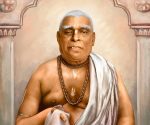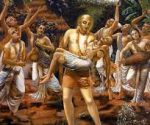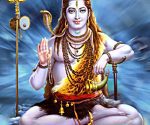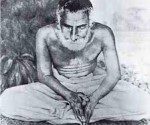Sri Madhvacharya – Dvaita School Of Philosophy
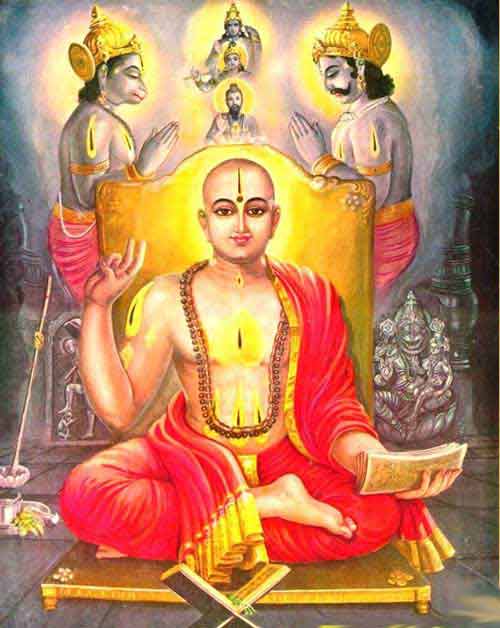 Dvaita, Advaita and Vishishtadvaita are the principal schools of Vedanta, each with its own community of followers, religious institutions and extensive philosophical literature in Sanskrit, and regional languages such as Kannada and Tamil.
Dvaita, Advaita and Vishishtadvaita are the principal schools of Vedanta, each with its own community of followers, religious institutions and extensive philosophical literature in Sanskrit, and regional languages such as Kannada and Tamil.
Sri Madhvacharya, (1238—1317) also known as Ananda Tirtha and Poorn Pragnya, is the founder of the Dvaita school of philosophy. His doctrine (Tattvavada) asserts that this world is real and there is no need to deny the existence of the world to realize God. Propagating the Bhakti marga or the path of devotion for God realization, Sri Madhvacharya preached dualism—the infinitely perfect God is independent and the world of matter and spirit is dependent on God.
Madhvacharya’s Vaishnavism is called Sad Vaishnavism or Brahm Sampradaya as opposed to Sri Ramanujacharya’s Sri Vaishnavism. He is regarded as the third incarnation of Vayu deva (the wind God) having descended into the mortal world in three successive incarnations—as Hanuman, the follower of Lord Rama in Treta Yug, as Bhim, one of the Pandavas in Dwapar Yug and as Madhvacharya in Kali Yug.
While Sri Sankaracharya preached Monism (Advaita), and Sri Ramanujacharya advocated a blend of Monism and Dualism, (Vishishtadvaita) Madhvacharya preached Dualism or Dvaita. He constantly emphasized that Sri Hari or Lord Vishnu is supreme and worship of Krishna as taught in the Bhagavat Puran was the centre of his religious precepts.
He laid much stress on constant practice of the remembrance of God (smaran). He says, “Form a strong habit of remembering God. Then only it will be easy for you to remember Him at the moment of death.’’
He believed that God was the continuing cause of all activities of man and prescribed Bhakti as the supreme means to attain God. He advocated that one should study the Vedas, learn to control senses, be dispassionate and completely surrender to the Lord.
Childhood and Early Life
Madhvacharya was born in 1238 of Tulu speaking Brahmins—Narayana Bhat (also called Madhyageha Bhat) and Vedavati in the village of Pajaka, about 20 kms from Udupi, in South Kanara district of Karnataka. His birth itself was anecdotal.
The parents had worshipped Lord Ananteshvar (Lord Narayan) for 12 long years to beget a worthy son and the Lord pleased with their prayers, took the form of a man and climbing the flag post in the village announced that Vayudev (Hanuman) would soon be born to revive Vedic dharma. There was an auspicious sound of the Dundhubi when Sri Madhva was born and the ecstatic parents named the child as Vasudev.
Even as a child, he was extraordinary in every respect, and repeatedly astounded his teachers, and performed several miracles. As a small child he had digested a basketful of cooked horse grain which his innocent sister had given him, unable to console him in the absence of their mother. While later the parents were worried about an infant being fed these grains, he was all cheerful and playing normally.
On yet another occasion he freed his father from the clutches of a loan shark, by giving him a handful of tamarind seeds which turned into gold when the creditor accepted the seeds.
He also killed the demon Mannimanta, who attacked him in the form of a snake, by crushing the snake’s head under his toe.
Even as a young boy of four years, Vasudev demonstrated his knowledge when he politely interrupted a Puranic discourse by correcting the narrator and offering his version which stunned listeners. His father discovered that anything taught to him was easily grasped and he had to teach him new concepts every day.
Soon it was time for Vasudev to begin his formal education. He was initiated into the sacred thread ceremony (upanayan) and sent to the gurukul of Totantillaya.
He was not only good at Vedic studies but also excelled in sports like swimming, wrestling, running race, and other physical activities. Although he was playful and not concentrating, he would flawlessly recite the hymns and lessons, including portions that the guru had not covered until then.
Towards the end of his stay in the Gurukul, Vasudev felt that he should become an ascetic and study the scriptures in search of their true meaning. After graduating from the gurukul, Vasudev’s thoughts centered around how he could give the innocent people a sound philosophy which glorified the Supreme Personality of Godhead, Lord Narayan-Vishnu.
Early years of Sannyas
At the age of eight or so, he announced to his parents his intention to take up sannyâs, and on noting their distress at this pronouncement, promised to wait until another son was born to them. Finally, at the age of eleven, upon the birth of a younger brother (who many years later joined his order as Vishnu Tîrtha) he was ordained into sanyâs, and was given the name Poorna Pragnya by his guru Achyutapreksha Tîrtha.
Soon afterwards, when his guru attempted to educate him, young Poorna Pragnya astounded the former by his knowledge and erudition. It is said that when his guru tried to teach him the noted Advaita text Ishhta-Siddhi, he pointed out, to Achyutapreksha Tîrtha’s amazement, that there were 30 errors in the very first line of that work. He reasoned out the errors with such sharp logic that there was no resistance from the guru or other followers.
Once he was asked to repeat the prose-passages of the Fifth Skandha of Bhagavat—a crucial test to find out the depth of his knowledge—and to everyone’s surprise, Poorna Pragnya repeated the text, page after page with perfect accuracy. Achyutapreksha Tîrtha soon gave up trying to educate Poorna Pragnya, and himself became a disciple, under the name Purushottama Tîrtha. Poorna Pragnya was then made the head of the institution of Achyutapreksha and he continued his teachings. Well-trained pundits and laymen alike gathered in large numbers to listen to his interpretations of the scriptures.
According to his teachings, the world is real, the individual souls are different from Brahman, and Vishnu is the Highest Entity in the universe. Many scholars of other schools came to him for debate and went back defeated by his keen and irrefutable logic.
During one such occasion, he debated Pandit Vasudev, a famous Advaita scholar for 40 days and won the debate. That is when he got the name Ananda Tirtha. He later assumed the name Madhva by which he is most commonly known today. It is said the words Ananda Tirtha and Madhva are synonymous. Both mean, “one who creates shastras that bring happiness.”
Tour to South India
To spread his teachings and debate with scholars, Madhva toured South India covering many places such as Vishnumangalam (near Kasargod), Trivandrum, Kanyakumari, Rameshwaram, Srirangam and a few other sacred places. Everywhere he went, he humbled scholars from other schools of thought with his powerful logic and oratory.
Once in the assembly of scholars, a discussion on the topic “Ithareya Sooktartha” was being held in the Sriranga temple. Madhvacharya propounded that the Vedas had three meanings, Mahabharat, ten and Vishnu Sahasranam, 100. There were differing opinions about it and to quell doubts, he began narrating hundred meanings in his interpretation for the word ‘Vishwa’ (the first word of the famed Vishnu Sahasranam) backed by grammatical illustrations. Even the scholars in the audience found it impossible to refute and accepted his deep knowledge.
It was also during his tour of South India that he performed yet another miracle—he is supposed to have gone to a place called Srimushna and created a water pond with his wand, to quench the thirst of a pregnant woman.
He started propagating dualism, the essence of Dvaita philosophy. His teachings emphasized that Hari (Sri Vishnu) is sarvottam and jagat (the universe) is satya and not maya (illusion).
He stressed that Hari (Vishnu) is the only entity praised in the Shrutis and their adjuncts. He always identified the Brahman of the Upanishads with Vishnu and forcefully argued against the dichotomy of Shrutis as claimed by Sri Shankaracharya.
In simple terms, he espoused fivefold differences among God, living things and non-living things. These are the Panch Bhedas in Dvaita philosophy. He used three methods to prove his philosophy, namely personal experience (pratyaksha), scriptures (agamas) and inference (anumana).
Panch Bhedas
Five-fold differences
· Between God and living things
· Between God and non-living things
· Between living and non-living things
· Amongst living things themselves
· Amongst non-living things
Basic tenets of Dvaita Philosophy
The basic tenets of Dvaita philosophy can be enumerated as below:
a. God (Brahman or Lord Vishnu) is the only independent and supreme being
b. The Universe which we inhabit is real and not a myth
c. Neither is there a beginning nor an end for God and the living beings—both are eternal
d. The Universe (Jada), living beings (jiva) and God (Brahman) are real but are mutually different
e. There exists no two identical objects (Jada) in this universe—all objects are mutually different.
f. Two living beings (jivas) are fundamentally different
g. There is a hierarchy among different living beings
h. Moksha or salvation is the realization of one’s own true nature and a state of permanent happiness.
i. It is only through Bhakti or devotion to God can one attain Moksha
His southern tour lasted for about two to three years and he returned to Udupi. Soon after, he began his career as an author and started writing a commentary on the Bhagvad Gita. The Gita Bhashya is the first work of Madhvacharya. He made a dispassionate study of the prevailing conditions and came to the conclusion that it was his duty to redeem the Vedic scriptures from being misinterpreted. For which he needed the blessings from Lord Vedvyas (an incarnation of Vishnu). It was believed that Vedvyas resided in the Himalayan regions in a remote place, unreachable by normal human beings. Madhva decided to undertake a pilgrimage to Badrinath.
Seven years after he took to holy orders Poorna Pragnya commenced a pilgrimage to the North where he touched Benares, Allahabad, Dwaraka, Delhi and other places and reached the famous Badrikshetra. After worshipping Lord Badri Narayan in the temple, Madhvacharya nursed a deep desire to go to Upper Badri, the abode of Lord Vedvyas and learn Vedanta from him. To achieve this mission, he undertook severe penance for 48 days without food and water and observed speechless meditation. One night Sri Vedvyas appeared before Madhva and invited him to visit his ashram in the upper reaches of Badri which is unapproachable to humans. Jumping from peak to peak like an expert mountaineer, Madhva reached the abode of Sri Vedvyas. That sacred place impenetrable to humans was splendid like Vaikunta. Madhvacharya prostrated before Lord Vedvyas and heartily extolled him. Vedvyas hugged him in great affection. Madhvacharya blissfully spent sometime enjoying the divine presence of the Lord.
Later with the permission of Lord Vedvyas he came to the shrine of Badrinarayan. Acharya had the orders of Vyasa to write a commentary on Brahma Sutras which would reflect their real views. He returned from Badri carrying their orders in all humility. Acharya, denouncing the earlier 21 commentaries on Brahma Sutras, wrote his own commentary. On his return, Acharya journeying through North and East India sowed the seeds of Vaishanava philosophy in Bengal. In the coming days it is that seed which sprouted, and grew into a tree nursed by Krishna Chaitanya, popularly referred to as Chaitanya Mahaprabhu (1486–1534). Even today it is being widely practiced by the members of the International Society for Krishna Consciousness (ISKCON) worldwide.
Later, in about A.D.1262, Madhvacharya came to Kalinga (present Orissa). During the reign of Rudrambe (A.D. 1261), daughter of Gajapathideva at Rajamahendri, the two great Advaita scholars Shobhana Bhatta and Shambu Shastri being humbled in debate by Madhvacharya became his disciples and took sannyasa. It is they who were the first to continue the tradition of Acharya and were renamed as Padmanabha Tirtha and Narahari Tirtha.




